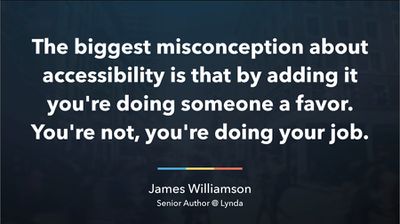Difference between revisions of "Why Accessibility"
(Created page with "== Why Accessibility == [https://twitter.com/jameswillweb/status/789212365325828096 400px]<br /> <br/> Accessibility is the act of...") |
|||
| Line 1: | Line 1: | ||
[[Category: Accessibility]] | |||
[https://twitter.com/jameswillweb/status/789212365325828096 [[File:Jameswilliamsaccessibilityquote.jpg|400px]]]<br /> <br/> | [https://twitter.com/jameswillweb/status/789212365325828096 [[File:Jameswilliamsaccessibilityquote.jpg|400px]]]<br /> <br/> | ||
Accessibility is the act of designing for an audience that includes people who have disabilities, and may (or may not) be using additional software or hardware to complete their goals. Accessibility is a way of thinking about design and development. [[Dylan Barrell]] explains it in his article "What is accessibility?" (which is no longer available) in terms of a series of traits. | Accessibility is the act of designing for an audience that includes people who have disabilities, and may (or may not) be using additional software or hardware to complete their goals. Accessibility is a way of thinking about design and development. [[Dylan Barrell]] explains it in his article "What is accessibility?" (which is no longer available) in terms of a series of traits. | ||
Revision as of 18:34, 5 May 2020

Accessibility is the act of designing for an audience that includes people who have disabilities, and may (or may not) be using additional software or hardware to complete their goals. Accessibility is a way of thinking about design and development. Dylan Barrell explains it in his article "What is accessibility?" (which is no longer available) in terms of a series of traits.
- Accessibility is empathy for your users.
- Accessibility is usability in the things you build.
- Accessibility is compliance with best practices, so you don't have to reinvent the wheel (or make your user do the same).
- Accessibility is making the experience better for all users, with an emphasis on the users at the edge of the experience.
- And Accessibility is practical - not idealistic - in its pursuit of a better experience.
(There's a great discussion of how a map can be accessible not by aligning with the letter of accessibility requirements, but by reassessing what the core user need actually is and building it instead or in addition to the map, in the article.)
Paul Boag raises many of the same points in his article Accessibility is not what you think, putting the emphasis on the fact that accessible solutions aren't strictly for the profoundly disabled edge cases. Yes, they are covered by good accessibility solutions, but good accessibility solutions benefit everyone. Accessibility is not a few things, though you'll meet people who think that it is. It is not a checklist of things to do so that your software passes a compliance test, a list of things to do so you don't get sued, or a pain in your ass. (Or rather, if it's a pain in your ass, so is User Experience and everything else that's going to make your product successful, so deal.)
Accessibility is not a "nice thing to do", as Karin Hitselberger explains in her article of the same name. It's the law. And it's the law because Karin and you and I all share the same rights to life and dignity and safety and security. It's not kindness, and it's not charity. It's the baseline.
Accessibility is not a 'Feature' and Developers Should Never Treat It as Such (by Michael Hansen on AppleVis). Similarly, Access is not Optional (by Tim Kadlec).
I've written a few things about Accessibility over the years, which can be boiled down to these two points: